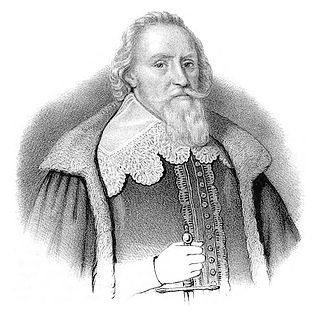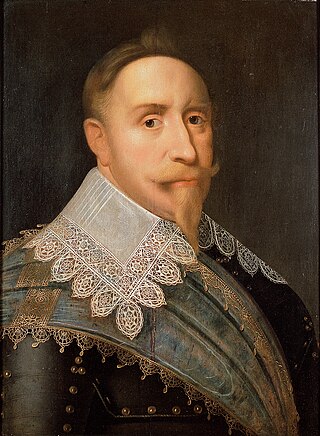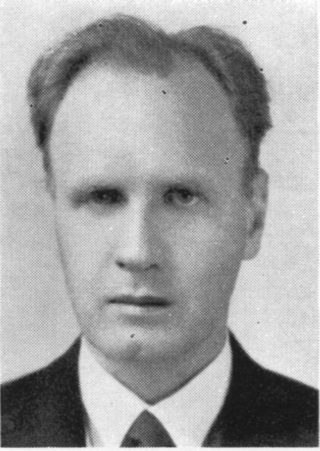
Charles IX, also Carl, reigned as King of Sweden from 1604 until his death. He was the youngest son of King Gustav I and of his second wife, Margaret Leijonhufvud, the brother of King Eric XIV and of King John III, and the uncle of Sigismund, who became king both of Sweden and of Poland. By his father's will Charles received, by way of appanage, the Duchy of Södermanland, which included the provinces of Närke and Värmland; but he did not come into actual possession of them till after the fall of Eric and the succession to the throne of John in 1569.

Ebba Magnusdotter Brahe was a Swedish countess, landowner, and courtier. She is foremost known for being the love object of King Gustavus Adolphus of Sweden, and because he wished to marry her prior to his marriage, plans which were however never realized. Their love affair has been famous in the Swedish romantic history and the subject of fiction, and are documented in their preserved correspondence.

The Ingrian War was a conflict fought between the Swedish Empire and the Tsardom of Russia which lasted between 1610 and 1617. It can be seen as part of Russia's Time of Troubles, and is mainly remembered for the attempt to put a Swedish duke on the Russian throne. It ended with a large Swedish territorial gain in the Treaty of Stolbovo, which laid an important foundation to Sweden's Age of Greatness.

Johan Skytte was a Swedish statesman, and the founder of the Academia Gustaviana, in 1632.

The Royal Gustavus Adolphus Academy in Uppsala is one of 18 Swedish royal academies and dedicated to the study of Swedish folklore. Its name is often expanded to Kungl. Gustav Adolfs Akademien för svensk folkkultur.
The Gustav-Adolf-Werk (GAW) is a society under the roof of the Evangelical Church in Germany (EKD) which has for its object the aid of feeble sister churches and congregations. It is responsible for the taking care of the diaspora work of the EKD, in cooperation with the EKD itself, its member churches and congregations. The organization started with a focus on the diaspora, but has separate branches internationally in the meanwhile. The organization in Austria is still called the Gustav-Adolf-Verein, which was the original name in Germany as well. Further terms used for the GAW in the past include Gustavus Adolphus Union, Gustav-Adolf-Stiftung and Evangelischer Verein der Gustav-Adolf-Stiftung.

Catherine of Sweden was a Swedish princess and a Countess Palatine of Zweibrücken as the consort of her second cousin John Casimir of Palatinate-Zweibrücken. She is known as the periodical foster-mother of Queen Christina of Sweden and the mother of Charles X of Sweden.

Count Magnus Brahe (1564–1633) was a Swedish noble. Being both Lord High Constable and Lord High Steward of Sweden, he was a notable figure in 17th century Sweden.

Tre Kronor or Three Crowns Castle was a castle located in Stockholm, Sweden, on the site where Stockholm Palace is today. It is believed to have been a citadel that Birger Jarl built into a royal castle in the middle of the 13th century. The name "Tre Kronor" is believed to have been given to the castle during the reign of King Magnus Eriksson in the middle of the 14th century.
Gertrud Elisabeth Forsselius née Forsell, also called Forselia, later known as Elisabet Haeffner and Elisabet Fahlgren, was a Swedish stage actress and opera singer. She belonged to the pioneer generation of the Royal Dramatic Theatre.
Margareta i Kumla also known as the Sibyl of Kumla, or Kumlapigan, , was a Swedish visionary, who claimed to be possessed. She became the target of pilgrimages when claiming to be the channel of the words of the angels.

Gustav III, also called Gustavus III, was King of Sweden from 1771 until his assassination in 1792. He was the eldest son of King Adolf Frederick and Queen Louisa Ulrika of Sweden.

Margareta Slots or Margareta Cabiljau was the royal mistress of king Gustav II Adolf of Sweden and the mother of his illegitimate son Gustav of Vasaborg.

Johannes Matthiae Gothus was a Swedish Lutheran Bishop of Strängnäs and a professor of Uppsala University, the rector of the Collegium illustrious, Collegium Illustre in Stockholm (1626–1629) and the most eminent teacher in Sweden during the seventeenth century. He was Bishop of Strängnäs from 1643 to 1664.

Gustavus Adolphus, also known in English as Gustav II Adolf or Gustav II Adolph, was King of Sweden from 1611 to 1632, and is credited with the rise of Sweden as a great European power. During his reign, Sweden became one of the primary military forces in Europe during the Thirty Years' War, helping to determine the political and religious balance of power in Europe. He was formally and posthumously given the name Gustavus Adolphus the Great by the Riksdag of the Estates in 1634.
Lovisa von Plat, also known under the names Platskan and Moster von Platen was a Swedish brothel owner and procurer, active in Stockholm for about forty years until her death. She belonged to the elite of her trade and became a known figure of her time, mentioned in memoirs, diaries and literature.

Events from the year 1628 in Sweden
Events from the year 1626 in Sweden

Crown Equerry is a title of the head of the Swedish Royal Stables. It is also an honorary title awarded by the king of Sweden. Previously at the Royal Court there was also a Master of the Horse who had the highest oversight of the Royal Stables. The Crown Equerry who was head of the Royal Stables, was named First Crown Equerry. Today Colonel Ulf Gunnehed is the Crown Equerry and head of the Royal Stables.

Dag Alvar Strömbäck was a Swedish folklorist, historian of religion and philologist. He was a professor at Uppsala University and also headed the Swedish Institute for Language and Folklore at Uppsala.














